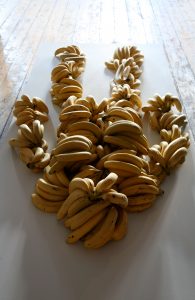ARTIST |
Justin Favela |
TITLE |
Plátanos Amarillos, After Francisco Oller |
YEAR |
2021 |
ARTIST’S COUNTRY OF ORIGEN |
United States |
DIMENSIONS |
83,8 x 53,3 x 5 cm |
MEDIUM |
Tissue paper and glue on board |
Credits: Photography by Mikayla Whitmore
Using a strategy of appropriation, Justin Favela recreates the iconic painting by Puerto Rican artist Francisco Oller entitled Plátanos amarillos. Favela created his version with coloured paper, making reference to the iconography of Oller’s work and to its material nature – including the frame of the painting to create a three-dimensional piece which reflects how focus of his work is an object in itself. The reference to Oller is not casual. In many of the artistic interventions which Favela has undertaken in different museums in the US he makes reference to objects in the collection of the museum which commissioned the work from him.
Plátanos Amarillos, After Francisco Oller was created specifically for the 2021 triennial of the Museo del Barrio in New York and Oller’s work is one of fundamental pieces in the museum’s collection. Oller’s painting, created in 1893, depicts a bunch of bananas in the process of ripening, hanging from a cord. Oller used skills gained in his painting studies in France to create images in a realistic style that alluded to his native culture. The banana is a fundamental part of the Puerto Rican diet and Oller’s painting acts as a kind of metonym for his cultural identity.
Favela uses the iconicity of this piece and its cultural resonance to reintroduce it into contemporary discourse, raising new questions about ways of creating art and its identity and materials. Favela’s works have a pop aesthetic, but their point of reference is not US pop culture but rather his Mexican and Guatemalan heritage. For Favela, piñatas provide an anchor point to his cultural identity, but also a link to manual labour, since they are generally made by families or women of lower classes in the towns of Central America. Favela explains that the piñata is simultaneously a symbol of celebration and of violence, as it is hit and destroyed at celebratory occasions. For the artist, who identifies as Latino, the piñata represents the appropriation and exploitation of cultural symbols which are converted into decorations within hegemonic cultures. Favela’s use of piñata-making paper as a main material for the creation of his works also questions the hierarchies of artistic academia. Whilst it has been assumed that painting and sculpture are the most worthy media for artistic creation, materials like those that Favela uses are associated with informal crafts. His ‘piñata paintings’, as he himself calls his works, directly question these hierarchies.



